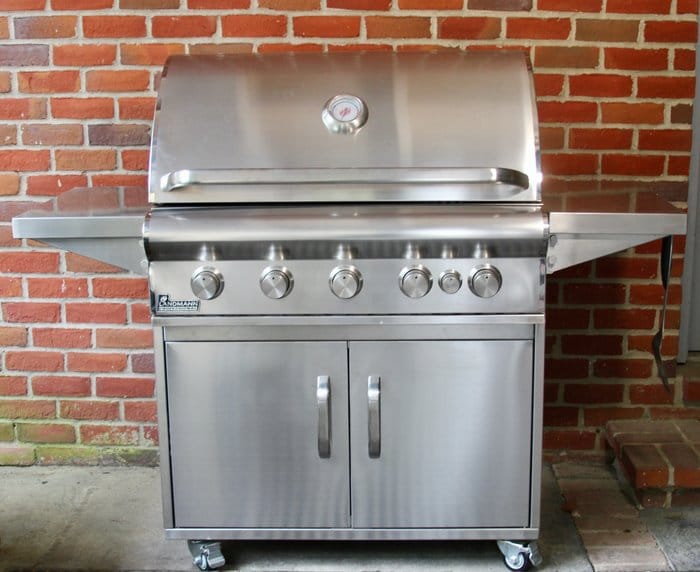Stainless Steel is a popular choice for grills and smokers. The types most commonly used in the manufacture of BBQ cookers are Austenitic and ferritic.
Because it contains more nickel and less steel in the alloy, the most common type of austenitic steel, called 304, is higher quality and higher cost. The most common ferritic steel, called 430, is not as durable and it is harder to weld properly. 430 contains more steel and magnets stick to it. 304 will not attract magnets. But don’t bother bringing magnets to a big box store on your next shopping trip. Most grills are 430 with the exception of some burners and grates, and many use more than two types of steel which can only be identified with a metalurgy gun. See the $35,000 model below. Only the most expensive cookers use 304 extensively.

The most significant problem with cheap grills is they often use very thin 430 stainless. These lightweight machines are pretty and shiny on the showroom floor but vulnerable to the demands of grilling. They can quickly develop minute stress fractures that lead to corrosion and reduced performance. They also lose their shine quickly and need polishing to maintain their sexy showroom look.
According to the AmazingRibs.com science advisor Prof. Greg Blonder, 430 is not as durable as 304 and it is harder to weld properly. “The welding heat remixes the steel microstructure away from optimum, so the weld often rusts or cracks. But very few grills at the low end are welded. Almost all bent and screwed.”
Don’t be afraid of 430, it does not deserve the derision common on the internet, but do look for heavy gauge construction throughout. Look at the screws, because sometimes they are not stainless and they will rust. Be advised that some manufacturers use heavier gauge steel on the lid and only the lid. They know it is one of the first things you will touch and a heavy lid creates a good first impression. They may even use 304 on the lid and 430 on the cart.
If you are choosing between stainless and other materials, select in favor of thickness. Thick powder coated steel or enameled steel will retain heat better than thin stainless and if properly coated, they will not rust. And coated steel is cheaper than stainless.
Stainless steel is so popular because it looks good. Alas, all stainless shows dirt, dust, grease, and rainspots and maintaining that beautiful shine is an ongoing task that many, including Yours Truly, cannot bear. Manufacturers recommend cleaning your grill after each use! Right. I don’t know anyone who does this.
Warm soapy water with a clean water rinse works well. Do not burnish stainless steel with a circular motion. Rub, wipe and polish in the direction of the grain. Do not use abrasive pads or steel wool. Covering your grill will keep it cleaner and extend its life.
There are a variety of cleaning products available from branded and generic stainless steel polish to disposable grill wipes. Read the labels. Some can damage your deck and furniture. If you’re so inclined to clean your grill, roll it onto your driveway, wash with warm soapy water, rinse with your hose, dry it off, then polish. But beware that these chemicals then find their way into the water table.
Blonder says “I pay more attention to cleaning the inside than the outside. On the outside, beware of kitchen cleaning products- they can erase the printed lettering around the knobs!”
I asked Meathead what he thinks and he said “I have a well-worn Char-Broil made with 430 and it is holding up fine after many years of heavy use. It looks like crap because I don’t cover it. If you are a neat freak you’ll go crazy polishing your smoker. But it’s a barbecue for cryin’ out loud. Who cares if it’s dirty on the outside?”
I’ve found that beer applied to the cook improves the appearance of my grill. Particularly when I know a load of tasty meat is sizzling under the lid!
Steel thickness
The thickness of steel is expressed in “gauge” numbers. The lower the gauge number, the thicker the steel. Here are some common gauge numbers of steel used in making grills.
| Gauge | Thickness |
|---|---|
| 10 | 0.1345″ |
| 12 | 0.1046″ |
| 14 | 0.0747″ |
| 16 | 0.0598″ |
| 18 | 0.0478″ |
Laser film

There is one minor hassle to buying stainless. If you have to do the assembly yourself, you may discover that the stainless parts come coated with a plastic film that protects the surface from scratches. It is not hard to remove, but it can take as long as an hour on a big grill.
The invention of stainless steel
In preparing this article, our science advisor, Prof. Greg Blonder, pointed out that the history of stainless steel is fascinating. Click here to read about how stainless steel was invented.



High quality websites are expensive to run. If you help us, we’ll pay you back bigtime with an ad-free experience and a lot of freebies!
Millions come to AmazingRibs.com every month for high quality tested recipes, tips on technique, science, mythbusting, product reviews, and inspiration. But it is expensive to run a website with more than 2,000 pages and we don’t have a big corporate partner to subsidize us.
Our most important source of sustenance is people who join our Pitmaster Club. But please don’t think of it as a donation. Members get MANY great benefits. We block all third-party ads, we give members free ebooks, magazines, interviews, webinars, more recipes, a monthly sweepstakes with prizes worth up to $2,000, discounts on products, and best of all a community of like-minded cooks free of flame wars. Click below to see all the benefits, take a free 30 day trial, and help keep this site alive.
Post comments and questions below
1) Please try the search box at the top of every page before you ask for help.
2) Try to post your question to the appropriate page.
3) Tell us everything we need to know to help such as the type of cooker and thermometer. Dial thermometers are often off by as much as 50°F so if you are not using a good digital thermometer we probably can’t help you with time and temp questions. Please read this article about thermometers.
4) If you are a member of the Pitmaster Club, your comments login is probably different.
5) Posts with links in them may not appear immediately.
Moderators